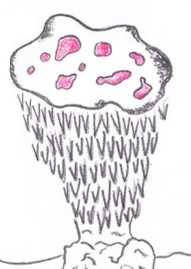
Habitat and Geography
The exact distribution of H. peckii has not been
definitively delineated for a variety of reasons. First,
many people simply aren't as interested in fungi as lions,
giraffes, hippopotami, and other charismatic megafauna. Even the breathtaking bleeding tooth fungus you ask? Yes,
unfortunately the eye-catching young pileus of H. peckii
is transient and quickly fades to a
lackluster form which is much less remarkable to random
passersby.
In addition, notable 'taxonmic confusion' is present in historical data of stipitate hydnoid fungi which has resulted in a questionable preliminary knowledge base (Newton et al. 2002). In particular, many have classified H.peckii and H. diablous synonymously because of the morphological similarity between them. Furthermore, until recently the only good way to assess the whereabouts of H. peckii was to send a troop of trained mycologists into the woods and have them count colonies of basidiocarps. Such an approach is flawed because H. peckii mycelia can exist underground for years without fruiting, so merely tallying basidiocarps does not take the mycelial organism without fruiting bodies into account. Recently, however, scientist have created 'species specific primers' that use DNA technology to detect particular fungal species, H peckii included, within a soil sample (Van der Linde et al., 2008). In spite of this advancement, studies assessing the span of stipitate hydnoid habitation have been considerably localized and have resulted in inconsistent, piecemeal data rather than an extensive global survey.
The map below (Roberts and Evans, 2011) shows an approximate distribution of H.peckii. It is important to note, however, that the data governing this distribution considers H. peckii and H. diabolus to be the same organism. In reality, the actually distribution of H.peckii is less expansive—H. peckii is found in the northern United States and Canada, while the distribution of H. diabolus extends along the eastern seaboard from Maine to Florida (Westmoreland, 2003).
Despite a slightly blurred picture of H. peckii distribution, there are many things about H.peckii's habitat we do know. To find H. peckii, you would have to search in a very particular milieu. The principle factor determining the location of H.peckii is the location of its symbiont tree; thus, H.peckii are nearly always found in coniferous forests. Besides that, H.peckii fancies sandy soils with poorly developed humus (topsoil) and minimal vascular plant cover. Due to such preferences, H.peckii is often found on banks and in old quarries as well as in mountainous and subalpine regions just below the tree line. H. peckii is also observed to fruit more prolifically in stands of older pines, as opposed to saplings, and in soils with low nitrogen content and (Holden, 2008). It is believed nitrogen deposition resulting from atmospheric pollution has been a key factor in the observed decline in H.peckii populations, particularly in areas of Europe.
As you will learn in more depth on the Interactions page, H. peckii is capable of forming ectomycorrhizal realtionships with numerous tree species. Like H. peckii, many other fungi form ectomycorrhizae and some trees are able to develop ectomycorrhizae with 40 or more different species of fungi(Moore, 2008). As a result, roots of ectomycorrhizal trees are often simultaneously occupied by a diverse collection of fungal symbionts. That means H.peckii can have neighbors including fungi from the genera Russula, Suillis, and Tricholoma (Visser, 1994).
Next stop: the life history and reproduction.

